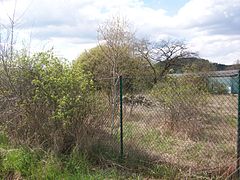Alt-Dernbach Castle
| Alt-Dernbach Castle | ||
|---|---|---|
|
Burgstall At-Dernbach - Remains of the tower hill |
||
| Alternative name (s): | Theyrinbach , Burschel, Butschel, Purzel, Dernbach Castle, Alt-Dernbach | |
| Creation time : | documented around 1050, 1263 | |
| Castle type : | Niederungsburg, Motte, outskirts | |
| Conservation status: | Remnants of the tower hill, small wall and moat remains, stone piles | |
| Standing position : | Nobles, knights | |
| Construction: | Truss | |
| Place: | Herborn - Seelbach | |
| Geographical location | 50 ° 41 ′ 49 " N , 8 ° 20 ′ 2" E | |
| Height: | 222 m above sea level NHN | |
|
|
||
The castle Alt-Dernbach , medieval Theyrinbach called later Burg Dernbach , Butschel or Topple is an Outbound small Wasserburg approximately 800 m southwest of the village center of Seelbach , a modern suburb of Herborn in Lahn-Dill-Kreis in Hesse .
location
The Burgstall is located at the tributary of the Dernbach into the Aar to the left of its river valley at a ford on the old cross connection Hohe Straße - Rennweg .
history
Alt-Dernbach Castle was first mentioned in 1263 in a document from the Marienstatt Monastery . In it a knight Bernhard von Dernbach gives the monastery a tithe. The small castle was probably never permanently inhabited, as there was no space for it in the castle area. The noble families lived outside. The castle seat in the Aartal should therefore be called a village. When comparing 1333 with the Counts of Nassau, the Dernbachers expressly retained their “5 farms in Dernbach”. In addition, a pleban Albertus zu Dernbach is mentioned in a document dated March 12, 1281 , which also suggests a place.

Alt-Dernbach was the original ancestral seat of the Lords of Dernbach, then owned by the Dernbacher Ganerbe (who had their own seal), who had been in dispute with the Counts of Nassau for over a century from around 1230 on. It was about the supremacy in the Herborner Mark . In addition to Alt-Dernbach, the Ganerbe also owned the Vetzberg Castle near Gießen ; there they called themselves sometimes von Dernbach, sometimes von Vetzberg, also with nicknames like: Rode, Krig, Holzappel, Mul and Graul.
In the course of the Dernbach feud , Nassau destroyed the castle in 1306. The Ganerbe sold their Theyrinbach Castle in order to have better support against the Nassau in 1309 to Landgrave Otto I of Hesse , the feudal lord of the Herborner Mark. He promised to rebuild it and build a city with it. At the same time he gave it back to the Ganerbe as an inherited castle loan. In the years 1326/27 the Nassau destroyed the not yet finished new castle in another violent dispute. It was not rebuilt after that. The lords of Dernbach sold in 1333 after the end of the feud all their rights, for. Some sovereign rights (including bailiwick rights, court rights, patronage rights, mining rights, customs duties, fishing and wild bans) in the Herborner Mark and in the Schelderwald and most of their possessions, except for the aforementioned five farms near Alt-Dernbach, for a proud price to the Count of Nassau. They withdrew from the now finally settled territory of Nassau and built before 1350, with the support of the Hessian Landgrave and the lords of Bicken to Hainchen the castle New Dernbach , west of Gladenbach in Landgraviate Hesse.
investment
Before 1300, Alt-Dernbach Castle was a small hilltop castle (Motte) with a defensive wooden or stone tower, for defense purposes. It stood on an artificially created hill in the Aar valley, surrounded by an earth wall and a moat .
A new building begun in 1309 with the help of Landgrave Otto von Hessen was never finished and destroyed in another feud by Nassau. When the geometer Johann Georg Schäfer measured the complex on behalf of the Counts of Nassau in 1780, he found an approximately oval floor plan including a moat approx. 83 m long and 60 m wide. During excavations at the beginning of the 1950s, the hill was still approx. 22 m by 16 m and the tower foundation had a base area of 3 m by 3 m.
Today only a small mound of earth can be seen in the meadow. These remains of the castle are called "Butschel" in the Seelbacher vernacular. At the beginning of 2014 a cairn with hewn stones, which probably belonged to the foundation walls of the tower castle, can be seen in front of the hill . The area is fenced and not accessible. Today there is a sheep farm on the old castle grounds.
literature
- Rudolf Knappe: Medieval castles in Hessen. 800 castles, castle ruins and fortifications. 3. Edition. Wartberg-Verlag, Gudensberg-Gleichen 2000, ISBN 3-86134-228-6 , p. 416.
- Horst W. Müller: Dernbach and the "von Dernbach" . Hinterländer Geschichtsblätter, No. 3 and No. 4, 2005 and No. 1 and No. 2, 2006, bulletin of the Hinterlander Geschichtsverein eV, Biedenkopf.
- Walter Bauer: excavations and finds on the castle hill of Dernbach / Dillkreis. In: Nassauische Heimatblätter, Vol. 49, 1959, pp. 22-52
Web links
- Alt-Dernbach Castle, Lahn-Dill district. Historical local dictionary for Hessen. In: Landesgeschichtliches Informationssystem Hessen (LAGIS).
- Heimatverein Seelbach : Herborn-Seelbach through the ages with a picture of the attempted reconstruction of the castle by Theodor Claas . The model is in the Herborn-Seelbach local history museum .





